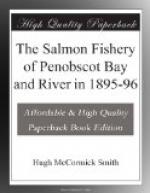During the years 1896 and 1897 over 2,000,000 young quinnat salmon and steelheads were deposited by the Commission in the Penobscot River and adjacent waters, several hundred thousand of which were four to six months old. The planting of additional fry and yearlings is contemplated in order to thoroughly demonstrate whether their introduction is possible.
The quinnat salmon ranges along practically the entire Pacific Coast of North America north of Mexico, entering all suitable streams. It is the most valuable member of the salmon family, and is taken in very large quantities for canning, salting, and fresh consumption. Its flesh is very rich and of a deep-red color. It is caught in the rivers with gill nets, seines, pound nets, traps, weirs, wheels, and other appliances. In Monterey Bay, California, large numbers are taken with trolling hooks baited with small fish, and, although the fish abstains from food after entering the fresh waters, it may often be lured with artificial or other baits. The chinook salmon begins to enter the California rivers in February, the Columbia in March, and the Alaskan rivers in May and June. The spawning season covers six months, extending from June to December, although the spawning period in any given basin is more limited, seldom exceeding one or two months. The highest accessible positions in the streams are sought by the spawning fish, which make rounded excavations in gravelly bottoms, in which the eggs are deposited. The vitality of the fish rapidly decreases after spawning, their bodies become mutilated and diseased, and in a short time they die.
The steelhead (Salmo gairdneri) also known by the names of salmon trout, winter salmon, and Gairdner’s trout, closely resembles the Atlantic salmon in size, form, and habits. It is found from southern California to Alaska, and enters the coast rivers in large numbers. Its flesh is light-colored, but is of excellent flavor, being not inferior to the eastern salmon. It is caught in large quantities with gill nets and traps, for canning and use in a fresh condition. As a game fish the steelhead enjoys a high reputation in the Pacific States. Its principal run in the rivers is during the fall and winter months, when it ascends the streams long distances, spawning in late winter or early spring.
In order that anglers, fishermen, fish-dealers, and others may be able to distinguish from the Atlantic salmon and from each other any specimens of quinnat salmon and steelhead that come to their notice, the following key [4] has been prepared to cover the principal differential characters, and illustrations of the three species are shown:




